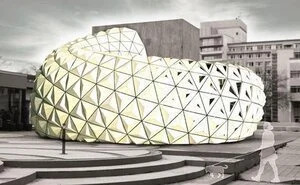3D Facades
3D facades are architectural elements that are used to add visual interest and dimension to the exterior of a building. They are often made using a process called thermoforming, which involves heating a sheet of plastic and then shaping it over a mold to create the desired shape.
One of the materials commonly used to make 3D facades is UV resistant ABS (acrylonitrile butadiene styrene). This plastic material is known for its strength, durability, and resistance to UV radiation, which makes it well suited for use in exterior applications.
To make a 3D facade using thermoforming, the first step is to design and create the mold that will be used to shape the plastic. This mold is typically made from a material such as metal or fiberglass and is designed to match the exact dimensions and contours of the desired facade.
Once the mold has been created, the UV resistant ABS plastic is heated until it becomes pliable. The heated plastic sheet is then placed over the mold and pressure is applied to push it down and conform it to the shape of the mold. The plastic is held in place until it cools and hardens, at which point it is removed from the mold and any excess material is trimmed away.
The finished 3D facade is then inspected for defects and any necessary finishing touches are applied, such as painting or adding hardware. These facades can be made in various shapes, sizes, and colors to meet the specific design requirements of a building.
The thermoforming process allows for the production of 3D facades in large quantities and at a relatively low cost. Using UV resistant ABS plastic helps to ensure that the facades will be durable and able to withstand the harsh conditions of the outdoor environment.
Overall, the thermoforming process is an effective way to create 3D facades using UV resistant ABS material. These facades can add visual interest and dimension to the exterior of a building, while also providing protection from the elements

